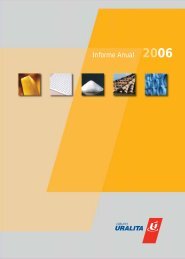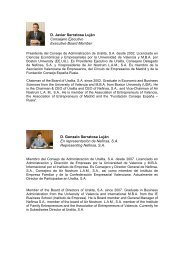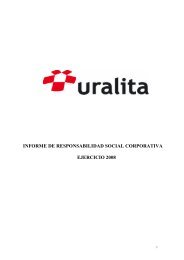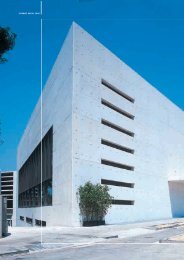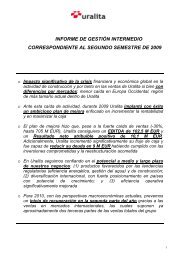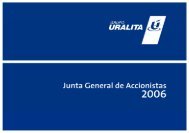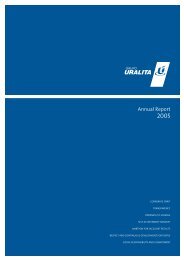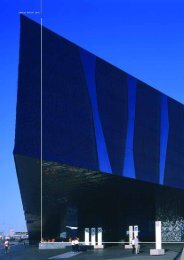Overview of the Uralita Group (259.5 KB)
Overview of the Uralita Group (259.5 KB)
Overview of the Uralita Group (259.5 KB)
Create successful ePaper yourself
Turn your PDF publications into a flip-book with our unique Google optimized e-Paper software.
History <strong>of</strong> <strong>the</strong> <strong>Uralita</strong> <strong>Group</strong><br />
1907 20’s-40’s<br />
50’s-60’s<br />
70’s-80’s<br />
90’s<br />
2003-2005<br />
Foundation<br />
First<br />
products<br />
• Fibre cement:<br />
- Coverings<br />
- Pipes<br />
New<br />
materials<br />
• Plastics<br />
• Expansion <strong>of</strong><br />
commercial<br />
network<br />
Diversification<br />
• Concrete and<br />
ceramic Ro<strong>of</strong> tiles<br />
• Pladur®<br />
Plasterboard<br />
Internationalisation<br />
• Poliglas and<br />
Pfleiderer<br />
(Insulation)<br />
Restructuring<br />
and pr<strong>of</strong>itable<br />
growth<br />
• Arrival <strong>of</strong> Nefinsa<br />
(Dec. 2002)<br />
• Strategic Plan<br />
2004-2006<br />
2007 will be <strong>the</strong><br />
<strong>Uralita</strong> <strong>Group</strong>’s<br />
centenary year<br />
<strong>Uralita</strong> began its life at <strong>the</strong> start <strong>of</strong> <strong>the</strong> twentieth century, when in 1907, it is one <strong>of</strong><br />
<strong>the</strong> first European companies to introduce a new building material that was to<br />
revolutionise <strong>the</strong> construction industry, fibre cement. The versatility <strong>of</strong> fibre cement<br />
permitted <strong>the</strong> development <strong>of</strong> a wide range <strong>of</strong> products: corrugated coverings,<br />
ornamental applications and piping.<br />
The explosion <strong>of</strong> plastics in <strong>the</strong> late 1950s led to <strong>the</strong> introduction <strong>of</strong> this material into<br />
construction techniques. New versions <strong>of</strong> <strong>Uralita</strong>’s traditional pipes and coverings<br />
were produced and marketed in every corner <strong>of</strong> Spain through <strong>the</strong> <strong>Group</strong>’s excellent<br />
sales network.<br />
In <strong>the</strong> seventies <strong>Uralita</strong> began to turn itself into a “<strong>Group</strong>” <strong>of</strong> companies, capable <strong>of</strong><br />
supplying <strong>the</strong> construction market with whatever it needed to complete a project.<br />
In 1974 it began producing concrete ro<strong>of</strong> tiles, a business complemented from 1985<br />
by ceramic ro<strong>of</strong> tiles and agreements with UK producer Redland (now part <strong>of</strong> Lafarge<br />
<strong>Group</strong>).<br />
In 1977 <strong>the</strong> <strong>Group</strong> introduced Spain to a new interior wall system that was already<br />
consolidated in <strong>the</strong> US, plasterboard, creating a market in which <strong>Uralita</strong> <strong>Group</strong>,<br />
through its Pladur® brand, remains <strong>the</strong> Iberian leader to this day. The seventies also<br />
saw <strong>Uralita</strong> breaking into sectors that it has now retreated from, such as paints,<br />
plastic containers, sanitary ware and ceramic ro<strong>of</strong> tiles.<br />
10



